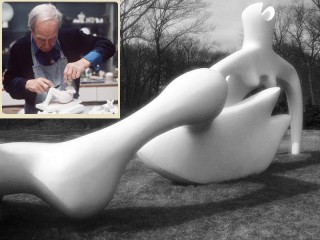
Moore Henry biography
Date of birth : 1898-07-30
Date of death : 1986-08-31
Birthplace : Castleford, Yorkshire, England
Nationality : British
Category : Arts and Entertainment
Last modified : 2010-05-12
Credited as : Artist sculptor, Abstract bronze sculptures, Knife Edge – Two Piece
Regarded as one of the most gifted and prolific sculptors of the 20 th century, Henry Moore began and solidified a tradition in art that was more organic and abstract. By his later years, his figures were massive and comprised of marble and bronze. He is noted for his amazing creations in what have been dubbed, reclining nudes.
Born in the north of England, young Henry didn’t have an upper-class upbringing. His father was a coal miner of Irish descent. In grammar school, however, Moore was given a scholarship to grammar school and was influenced greatly by his art instructor to pursue his talents. Following his productive and happy years at grammar school, Moore was sent to France to serve in the British Army. After, he was given a grant that allowed him to enroll in the Leeds School of Art, where he was finally given the chance to study sculpting. Upon his graduation, he won another scholarship to the Royal College of Art in London and in two years graduated.
After some post-graduate work, Moore became enthralled with works that were non-Western. In the London museums, he began studying Eastern, African, and South American works that had been collected and put on display. He found that their abstract sense, although primitive, had taken art back to what it was intended – a representation of human feeling. After some time serving as an instructor at the Royal College, Moore was given a scholarship to study in France and Italy, where he began his works of reclining women.
Moore became fascinated with art from Mexico, namely plaster casting sculptures. After just two years, Henry Moore showed off his work at the Warren Gallery in London. Moore also worked on some newly commissioned sculptures for the city, and began working more closely with a group known as Unit One. Their goal was to raise public awareness about art movements abroad. In the 1930s, the British public began paying more attention to the abstract movements of the day. However, this art didn’t come without consequence. Many critics found his work disdainful and Moore was later asked to resign from the Royal College of Art. He then began to work for other academies in London.
He was influenced greatly by Pablo Picasso, and kept on working on his own art regardless of the critics’ reviews. By the mid-1960s and into the 1970s, Moore went to the United States where he worked on sculptures for the Lincoln Center in Chicago and the University of Chicago.
Legacy
Most sculptors who emerged during the height of Moore's fame, and in the aftermath of his death, found themselves cast in his shadow. By the late 1930s, Moore was a worldwide celebrity; he was the voice of British sculpture, and of British modernism in general. The next generation was constantly compared against him, and reacted by challenging his legacy, his "establishment" and his position. At the 1952 Venice Biennale, eight new British sculptors produced their Geometry of Fear works as a direct contrast to the ideals behind Moore's idea of Endurance, Continuity.
Herbert Read coined the phrase for these "Young British Sculptors" when he wrote of the Biennale, "Here are images of flight, of ragged claws 'scuttling across the floors of silent seas', of excoriated flesh, frustrated sex, the geometry of fear". The works alluded to rib and cage forms, insect shapes, and to aggression and predation. Read drew a direct connection and continuity between these new sculptors—all were under 40—and Moore, but in fact they were driven by a need to find a new beginning in art. Some had no formal artistic education, and, coming from a generation decimated by the war, only sought to be rid of the past.
Yet Moore had a direct influence on several generations of sculptors of both British and international reputation. Among the artists who have acknowledged Moore's importance to their work are Sir Anthony Caro, Phillip King and Isaac Witkin, all three having been assistants to Moore. Other artists whose work was influenced by him include Lynn Chadwick, Eduardo Paolozzi, Bernard Meadows, Reg Butler, William Turnbull, Robert Adams, Kenneth Armitage, and Geoffrey Clarke.
Today, the Henry Moore Foundation manages the Henry Moore Institute in Leeds which supports exhibitions and research activities in international sculpture. By the Foundation's own admission, popular interest in Moore's work has declined since his death, yet the institutions he endowed continue to play an essential role in promoting contemporary art in the United Kingdom.
Notable works
- Knife Edge – Two Piece (1962) is a bronze opposite the House of Lords, London
- Three Way Piece No. 2 (The Archer), (1964-1965), Toronto City Hall Plaza
- Two Piece Reclining Figure No. 5, Bronze, (1963–1964), in the grounds of Kenwood House, London
- Three Piece Reclining figure No.1, (1961), Yorkshire Sculpture Park
- Oval with Points, (1968-1970), Henry Moore Foundation
- Hill Arches, (1972-1973), Bronze, National Gallery of Australia
- Large Divided Oval: Butterfly (1985-1986), Haus der Kulturen der Welt, Berlin
- Draped Seated Figure at the Hebrew University of Jerusalem
















